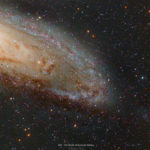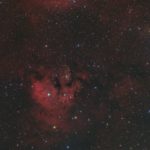M33 is a galaxy about 2.8 – 3 million light years away in the constellation of Triangulum. Along with M33, it is one of the Local Group of galaxies with which our own Milky Way galaxy shares the local universe. M33 is the most distant object that the human naked eye can see, appearing as a ghostly white smudge on a very dark night from clear skies. It is a magnificent spiral galaxy about half the size of our own galaxy and because of its close proximity to us it appears very large in our skies and is am oft-photographed object by many, myself included.
I’ve imaged M33 multiple times. For example, with the same FSQ85 telescope here and also at a closer image scale with the TEC140 refractor here.
This time I have set the galaxy in a slightly wider field by utilising the FSQ85 0.73 reducer. I used the Moravian G2-8300 CCD camera and Astrodon RGB filters all binned 1×1. I did not use a separate luminance channel.
The data collected for the image was collected from my backyard observatory in Nottingham, UK on 4/5 and 8th of November 2021 and is a modest data set of 15 x 300s exposures in each of the three filters to give a total integration of nearly four hours. However, because of the proximity of M33 and its brightness this data set has revealed a very pleasing, detailed and colourful result. What do you think?
Image data captured with NINA automation software and processed in PixInsight.




